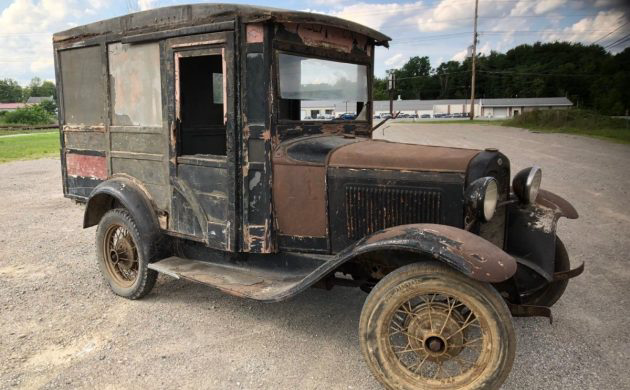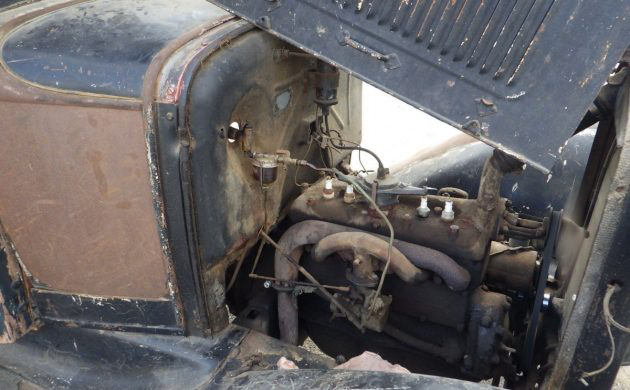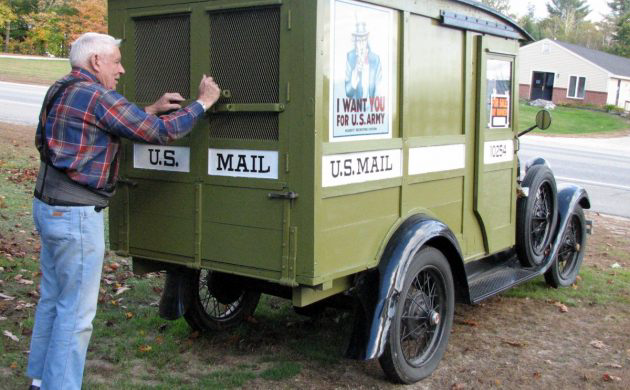Many years ago my wife used to deliver the mail in an area of rural Tasmania. Thankfully it wasn’t so long ago that she would have had to use a mail truck of this vintage. I guess that it’s our loss. Located in Cincinnati, Ohio and listed here on eBay is this great little slice of history. With a clear title bidding is up to $6,500 with 3 days remaining on the auction.
To me cars from this era were something a bit special. They reflected a level of ingenuity that we rarely see today. A lot of that is a result of ever-tightening safety and design rules, all designed to protect us if things go horribly wrong. I mean, can you imaging making similar modifications to a new F150 and the authorities letting you go? There is a significant amount of timber in this particular car, and in spite of its age, a surprising amount of it appears to be salvageable if the new owner were to decide to undertake a full restoration. The great thing is if you’re handy with woodworking tools you can fabricate almost every part that you might need. And if you get it wrong? Firewood! The body is generally solid with a few areas of rot that will need to be addressed. The forward roof rail is probably the worst. The driver’s door is missing along with the bumpers. The seller believes that he may have a spare front bumper and if he does he will include that in the sale.
I love the rear cargo area. The sliding door between the driver’s compartment and the rear is brilliant. The seller states that as he understands it the location of the spare tire is pretty standard for these vehicles, which were built by the Mifflinburg Body Company in Pennsylvania. Eventually the company produced around 1,000 of these as the US Congress sought to replace its aging Model T Postal Fleet with the Model A.
Yes, it runs and drives. The seller states that the car runs and drives. He says that the transmission can grind slightly moving from neutral into gear if the revs are too high, but he has driven it around his yard at 15-20mph and it feels great. Apparently it doesn’t overheat and there are no major oil leaks. He is so confident about the mechanical integrity of the vehicle that he states that if it had better tires and working lights then he’s happily drive it on the streets today. He states that the tires hold air, but that a couple do leak down over a few days.
The interior is pretty bare, as befits a vehicle of this purpose. These were a strictly utilitarian vehicle with few frills or luxury. The driver’s seat frame is missing, hence the rather creative use a milk crate as an alternative when the seller drives the vehicle. Unfortunately there are no shots of the dash, but being a Model A most missing parts should be able to be sourced at reasonable prices. Some of the timber flooring is going to need replacing, but the shots of the underside of the car indicate a vehicle that appears to be quite solid.
So, what did it look like when it was shiny and new? A lot like this one. When it comes to vehicles from this era it is hard to use the term “unique” because there were so many coach builders who customized almost anything to meet a customer’s requirements. That also makes it hard to set an accurate value on this particular car. If you are a car buff and are heavily into the history of the US Postal Service, then this may well be the crowning jewel in your collection.






This would be worth restoring and should be a lot of fun to own and drive.
Do you remember that flower shop on Olive Avenue in Burbank that used one of these all through the ’60s and ’70s. Right on the corner of Myers and Olive or were you gone from Burbank by that time??
Hey! What about reproducing all those
wooden parts with a 3-D printer? You
could save a bundle on repairing the
wooden parts and have a mail truck
that is absolutely termite and rot proof!
And yes, it is amazing just how adaptable
the Model A really was. Reminds me of
the Douglas DC-3–it never ran out of uses.
This is awesome. My dad’s friend restored a 1930 Model A UPS truck (go brown!) that was in far worse shape. The tough parts are the hardware and trim pieces specific to the USPS body, but as mentioned above – 3D printing might be a great option.
Great historical find! It would represent a business proudly! I think that car nuts would stop just to look at it out front of the business then I guy could make a sales pitch to them! Sales bait! LOL
The USPS in Minneapolis was still using these up into the late ’40s. They probably couldn’t replace them during WW II. If memory serves, the first replacements were late-40s Internationals.
Back in ’69 I noticed that there was one of these sitting in the woods behind the home of the a couple that both worked in the local Post Office, in fact the Post Office livery was all still very readable, as I recall there was “US Post Office” emblazoned on the panel above the windshield. Wasn’t a very exciting “find” for me at the time, they had other cars sitting next to it that were much more interesting to me (47 Cad convert, 55 Hudson Hollywood Hornet w/ cont kit, etc) but it was all considered scrap at the time, and that part of the forest was cleared just a couple of years later, all the cars were hauled away (including that Model A P.O. truck) and homes built. We called it progress!
Leave it as is nothing more excites me in a vehicle than all original with a clean title I’m all for preserving factory assembly in these old clunkers.
Very cool vehicle and it sure looks like a reasonable resto. It’s very interesting just how 3D printing is going to benefit guys like us who restore vehicles. I owned a computer company for 30 years, I was so busy growing and running the Co. I never had time to play with anything cool like that!!
Interested in this kind of vehicle? Your local Model A Ford club is a wonderful resource. There is lots of help out there if you are interested in the Model A Ford.
Cool idea for rare parts for any car. Create a 3D replica part, create mold, lost wax technique to pour a new one!
George you sure are correct and if you designed this for common cars like old Camaros etc you could either sell the completed paperwork or publish the data and charge a subscription for folks to access the data. This concept could change a whole lot of things?